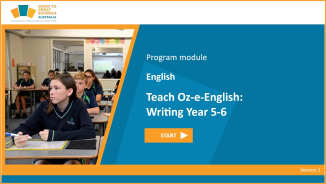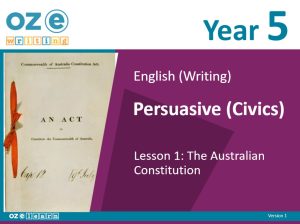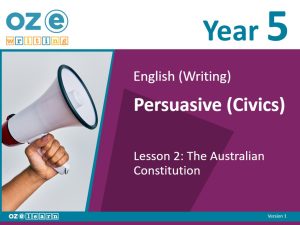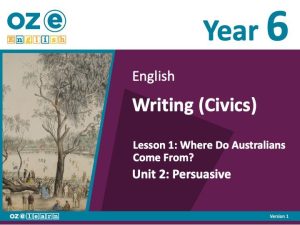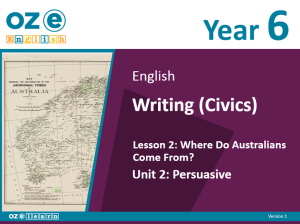Oz-e-English Writing (Civics)
Unit 2: Persuasive
The Writing (Civics) units align to the Australian Curriculum Content Descriptions for Language and Literacy
Free Starter Lessons
Year Overview
Year 5
Australian Curriculum Content Descriptions
Overview
Unit 2: Persuasive – Year 5 is an English language strand unit for Year 5 students. It aligns to the Australian Curriculum English Year Level Achievement Standards:
- Identify the numerous ways in which noun groups and adjective groups and phrases can be expanded to give a more thorough description of a person, place, thing or idea. (ACELA1508)
- Create and publish creative, persuasive and informative print and multimodal writings, selecting text structures, linguistic elements, images and sound that are appropriate for the purpose and audience. (ACELY1704)
- Understand that a complex sentence contains at least one subordinate clause as well as the distinction between main and subordinate clauses. (ACELA1507)
- Be aware that vocabulary can be used to convey meaning more precisely and that different circumstances can give words varied meanings. (ACELA1512)
- Recognise how to spell innovative words by applying your understanding of existing words, base words, prefixes, suffixes, word origins, letter patterns and generalisations about spelling. (ACELA1513)
- Examine unusual plurals and learn how a word’s meaning or grammatical structure can be altered by a suffix. (ACELA1514)
- Reread and edit the work of the student and others using established standards for the language and text structures. (ACELY1705)
Note: The content on this page is subject to change as this program is being updated to comply with Australian Curriculum version 9.0 and may change at any time. In the first quarter of 2024, GGSA will issue an updated version.
Learning Objectives
In Lessons 1 to 45, students will:
- Examine the structure and cohesion of a persuasive text.
- Read and create persuasive texts for different purposes audiences.
- Read persuasive messages and create them for a variety of audiences and objectives.
- Analyse how a text’s coherence and structure might make the message easier to comprehend.
- Learn how to use noun groups, verb groups and direct appeals to persuade an audience using language elements.
Success Criteria
- Create an OREREO-structured plan for a persuasive writing.
- Write a persuasion text using the OREREO format.
- Use the OREREO structure to edit a persuasive text.
- Construct a convincing text using the OREREO method.
Assessment
Progress Test
A total of four progress tests worth a combined 40 per cent of the final grade are conducted in Weeks 2, 4, 6 and 9.
Progress tests enable teachers to keep track of students’ learning of the material covered and pinpoint areas that require additional instruction. The Student Workbook contains progress tests.
End-of-Unit Assessment
The end-of-unit assessment is given in Week 7, and contributes 60 per cent of the total grade. Each unit’s success criterion is addressed by this assessment, which is part of the Student Workbook.
Year 6
Australian Curriculum Content Descriptions
Overview
- Understand that language varies as levels of formality and social distance increase. (AC9E6LA01)
- Understand the uses of objective and subjective language and identify bias. (AC9E6LA02)
- Explain how texts across the curriculum are typically organised into characteristic stages and phases depending on purposes, and recognising how authors often adapt text structures and language features. (AC9E6LA0)
- Understand that cohesion can be created by the intentional use of repetition and the use of word associations. (AC9E6LA04)
- Understand how embedded clauses can expand the variety of complex sentences to elaborate, extend and explain ideas. (AC9E6LA05)
- Understand how ideas can be expanded and sharpened through careful choice of verbs, elaborated tenses and a range of adverb groups. (AC9E6LA06)
- Identify and explain how images and figures contribute to meaning, tables, diagrams, maps and graphs. (AC9E6LA07)
- Identify authors’ use of vivid and emotive vocabulary such as metaphors, similes, personification, idioms, imagery and hyperbole. (AC9E6LA08)
- Responses to characters and events in literary texts drawn from historical, social or cultural contexts by First Nations Australian, wide-ranging Australian and world authors. (AC9E6LE01)
- Explain the way authors use sound and imagery to create meaning and effect in poetry. (AC9E6LE04)
- Examine texts including media texts that represent ideas and events, and identify how they reflect the context in which they were created. (AC9E6LY01)
- Use interaction skills and awareness of formality when paraphrasing, questioning, clarifying and interrogating ideas, developing and supporting arguments, and sharing and evaluating information, experiences and opinions. (AC9E6LY02)
- Analyse how text structures and language features work together to meet the purpose of a text, and engage and influence audiences. (AC9E6LY03)
- Select, navigate and read texts for a range of purposes while monitoring meaning and evaluating the use of structural features; for example, tables of contents, glossary, chapters, headings and subheadings. (AC9E6LY04)
- Use comprehension strategies such as visualising, predicting, connecting, summarising, monitoring and questioning to build literal and inferred meaning, and to connect and compare content from a variety of sources. (AC9E6LY05)
- Plan, create, edit and publish written and multimodal texts whose purposes may be imaginative, informative and persuasive using paragraphs, a variety of complex sentences, expanded verb groups, tense, topic-specific and vivid vocabulary, punctuation, spelling and visual features. (AC9E6LY06)
- Plan, create, rehearse and deliver spoken and multimodal presentations that include information, arguments and details that develop a theme or idea, organising ideas using precise topic-specific and technical vocabulary, pitch, tone, pace, volume, and visual and digital features. (AC9E6LY07)
It also aligns to the Australian Curriculum: Civics and Citizenship Year Level Achievements Standards:
- Students learn about the key institutions of Australia’s system of government, how it is based on the Westminster system and the key values and beliefs of Western democracies. (AC9HS6K06)
- Students learn about the roles and responsibilities of the three levels of government in Australia. (AC9HS6K07)
Learning Objectives
In Lessons 1 to 45, students will learn to examine Civics and Citizenship subjects that are covered in exemplar texts:
- Where do Australians Come from?
- Who Are We?
- Bonding Identities
- Our Ancestors
- Our Future Unborn
- A Fair Go
- Mateship: How Do We Live together?
- Leadership: Who Are We? Bridging Identities.
Students will also learn to recognise the organisational principles of persuasive writings and transform informative text models into persuasive messages. They will create convincing texts, express their viewpoints, and rely on both their prior knowledge and latest information.
Success Criteria
- Students will investigate topics of Civics and Citizenship presented in informative text exemplars.
- Identify the main ideas of the educational civics text and make notes on them.
- Learn how to recognise civics information and apply it to persuasive writing.
- Joint construction of a civics persuasive text.
- Plan, draft, write and edit an effective civics text.
Assessment
Progress Test
A total of four progress tests worth a combined 40 per cent of the final grade are conducted in Weeks 2, 4, 6 and 9.
Progress tests enable teachers to keep track of students’ learning of the material covered and pinpoint areas that require additional instruction.
End-of-Unit Assessment
The end-of-unit assessment is given in Week 7, which contributes 60 per cent (30 per cent writing and 30 per cent civics) of the total grade.
Each unit’s success criterion is addressed by this assessment.
Other Units
Lesson Design
Lesson Objective
Success Criteria
Activating Prior Knowledge
I Do
We Do
Apple Question
You Do
Revise
Professional Learning
